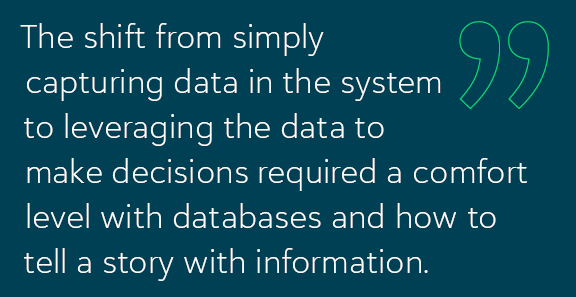Looking Back at 30 Years of Evolving Technology in Nonprofit Finance

Manual typewriters. Paper checks. Handwritten ledger books. A bottle of bleach at the ready for ink-inscribed mistakes.
This isn’t the start of a dystopian accounting novel. It’s what the nonprofit finance office looked like only a few decades ago. Managing change can be difficult, but in looking back over the past 30 years of technology, it’s easy to see the benefits of continued evolution.
In a recent webinar, we talked with nonprofit experts Natalie C. W. Smith, Controller at The Duke Endowment and Joseph Ali from PKF O’Connor Davies about the shifts in nonprofit finance over the past three decades. It was clear from the conversation that managing change requires more than new hardware and software.
To best serve the needs of your organization, nonprofit financial leaders must think through how you can empower intentional change management in your people, processes, and technology. Turns out, there are quite a few similarities between moving from hand-written ledgers and 10-key data entry to the shift from spreadsheets to AI-powered automated workflows.
Managing the Financial Technology Mindshift
Moving from ten-key data entry to point-and-click data manipulation required nonprofit finance teams to think differently about their processes and what’s possible, similar to what’s happening today with automation and AI-powered functionality in fund accounting software.
When computers were first incorporated into the finance office, employees were introduced to the black screen of DOS. This operating system enabled finance teams to store and retrieve information, making them more secure and reliable than handwritten logbooks. Once team members got used to the 10-key number pad, they were highly efficient at data entry. They didn’t even need to look at the screen.
Electronic data entry and storage was an improvement over the heavy ledgers, but it didn’t require employees to think differently about the information. Instead of writing the ledger entries in the book, they typed them into the computer. But when Microsoft Windows 1.0 was released in 1985, it caused a significant shift in not only what the finance team could do with their data, but also how they did it.
The point-and-click, folder-based interface made accountants and finance employees look up at the screen and think about how the files should be organized. The growth of spreadsheet software like Microsoft Excel got people looking at the numbers as more than records. They could easily sort, filter, and calculate, getting a different perspective on the once-static entries.
Because finance employees were no longer heads-down over the 10-key, there was an initial slow-down in efficiency as employees got accustomed to the point-and-click interface. A similar slowdown is likely to affect teams in the near future as new technology such as blockchain, verifiable ledgers, automation, and instantaneous financial markets become commonplace.
Managing Financial Stewardship During Technological Advancement
There is a trickle-down effect from innovations and regulations of the for-profit sector. Often what’s happening in the for-profit sector gives nonprofit organizations new tools for growth and opportunities to tighten their internal controls.
The Sarbanes-Oxley Act of 2002 was a direct result of several high-profile accounting scandals of the late 1990s and early 2000s, causing Congress to tighten auditing and public disclosure regulations. Increased privacy laws such as FERPA and HIPPA also made their way into law. These directives changed the expectations of stakeholders, including donors and funders, about the transparency of information.
For-profit organizations, such as banks and other financial institutions, adopted new technology to more efficiently meet the higher standards, and this forced consumers to get comfortable with processing payments online. Consumers also got accustomed to having more information about their finances at their fingertips.
These increased expectations drove not only better technology, but also more specific skill sets. CTOs and CIOs began appearing in nonprofit org charts in the early 2000s as well, a few years after those roles became commonplace in for-profit organizations. The financial team required more specialized training as well, with CPA designations starting to be required for the CFO position.

These technological advancements and changing expectations also gave rise to the role of the analyst. The shift from simply capturing data in the system to leveraging the data to make decisions required a comfort level with databases and how to tell a story with information. And the tools evolved to support this, with finance teams looking for more automated tools.
As technology grew, so did the investment options available to finance teams in the philanthropic sector. In the late 1990s and early 2000s, organizations began diversifying their portfolio past simple dividends and income. The finance office now needed to understand investments, risk management, diversification, and unrealized vs. realized gain.
Managing the Pace of Technological Change
In looking back over the past 30 years, it’s clear that change happens whether an organization is ready or not. Imagine if you were trying to run your financial team with hand-written entries in logbooks today.
Nonprofits rarely lead the way when it comes to technological innovation, but they do need to be intentional about keeping pace with advancements in the marketplace. You won’t always be able to see exactly what’s on the horizon, but there are a few ways nonprofit financial leadership can make intentional changes to manage the pace of technological change.
Watch and understand the shifts in demographics and changing preferences.
As consumers in general become comfortable with different technologies, they will want to see those technologies reflected in the organizations they support. From peer-to-peer fundraising to cryptocurrency, there will be a push for a variety of donation sources. This includes the rise of donor-advised funds (DAFs) and an increase in Community Foundations.
Break down silos to make more contextualized decisions.
The financial team touches all areas of the organization, from invoices paid to budget planning. With that knowledge, it’s important for the financial team to actively work with development and leadership to support the organization’s strategy instead of being a reactive reporting function. Everyone is responsible for good organizational stewardship.
Be prepared for major events.
You don’t always know what the next crisis will look like, but you know there will be one. Document your processes and review your policies to see where you can be flexible, such as with hybrid and remote work. When most people in the nonprofit sector could work remotely during COVID, finance teams needed to be in the building in some capacity almost daily to receive checks and make deposits. Find ways to be completely paperless so your teams can be more flexible in when and how they work. Look for opportunities to be agile and incorporate them before you have to.
Preparing Your Nonprofit Finance Team for Change Management
Understand that these changes take time, and there is often a slowdown in productivity as the team finds new ways to apply the technology. Provide opportunities for your team to speak into the change management process, either to recommend new ways of working or to highlight processes that shouldn’t change.
For a deeper dive into the shifts in the nonprofit finance office over the past 25 years, check out our infographic, The Major Shifts in Technology for the Nonprofit Finance Office.



